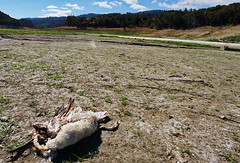USDA (Headed by TomVilsack, former Monsanto man)‘partially deregulates’ GM sugar beets, defying court order
On Friday, the agency didn't simply skulk away from its own words in an apparent attempt to appease the agrichemical industry. This time, it defied a court order banning the planting of GM sugar beets until a proper study of their environmental impact can be done. The USDA announced that it would allow farmers to begin planting Monsanto's Roundup Ready sugar beets -- genetically tweaked to withstand copious lashings of Monsanto's herbicide -- even though the environmental impact study has yet to be completed, The Wall Street Journal reports.
"The USDA (Headed by TomVilsack, former Monsanto man. -Clean Food Earth Woman)decision is the second big victory for the crop-biotechnology industry in a week," the Journal noted.
Sugar beets provide about half of the sugar consumed in the United States -- and Monsanto controls 95 percent of the sugar beet seed market with its Roundup Ready genes. The company's stranglehold over the beet market demonstrates its insidious market power. When a federal judge demanded in August 2010 that farmers stop planting Monsanto's GM beet seeds pending an impact study, farmers quickly found out that virtually no non-GM seed was available. Between 2005, when the USDA first greenlighted GM beets, and 2010, Monsanto had essentially driven all competition out of the market.
That August court order roiled the food industry, raising the specter of higher sweetener costs because farmers would be forced to plant fewer beets due to lack of seeds. Rather than seeing this effect as an opportunity to reduce U.S. sweetener consumption, the USDA (Headed by TomVilsack, former Monsanto man. -Clean Food Earth Woman)evidently saw it as a crisis that needed to be addressed by defying the court order.
As with alfalfa, blanketing cropland with GM beets raises the threat of cross-pollination -- genetic material from modified beets could make its way into organic table beet and chard crops, both of which can cross-pollinate with sugar beets. Moreover, the problem of "superweeds" -- weeds resistant to Monsanto's Roundup herbicide, which require heavier doses of more powerful herbicides -- will only compound.
But the decision didn't reflect a complete cave-in to the industry, according to the Journal:
"The USDA (Headed by TomVilsack, former Monsanto man. -Clean Food Earth Woman)decision is the second big victory for the crop-biotechnology industry in a week," the Journal noted.
Sugar beets provide about half of the sugar consumed in the United States -- and Monsanto controls 95 percent of the sugar beet seed market with its Roundup Ready genes. The company's stranglehold over the beet market demonstrates its insidious market power. When a federal judge demanded in August 2010 that farmers stop planting Monsanto's GM beet seeds pending an impact study, farmers quickly found out that virtually no non-GM seed was available. Between 2005, when the USDA first greenlighted GM beets, and 2010, Monsanto had essentially driven all competition out of the market.
That August court order roiled the food industry, raising the specter of higher sweetener costs because farmers would be forced to plant fewer beets due to lack of seeds. Rather than seeing this effect as an opportunity to reduce U.S. sweetener consumption, the USDA (Headed by TomVilsack, former Monsanto man. -Clean Food Earth Woman)evidently saw it as a crisis that needed to be addressed by defying the court order.
As with alfalfa, blanketing cropland with GM beets raises the threat of cross-pollination -- genetic material from modified beets could make its way into organic table beet and chard crops, both of which can cross-pollinate with sugar beets. Moreover, the problem of "superweeds" -- weeds resistant to Monsanto's Roundup herbicide, which require heavier doses of more powerful herbicides -- will only compound.
But the decision didn't reflect a complete cave-in to the industry, according to the Journal:
The USDA (Headed by TomVilsack, former Monsanto man. -Clean Food Earth Woman), in a move that seemingly expands its regulatory powers over crop biotechnology, will for the first time "partially deregulate" a genetically modified crop. USDA (Headed by TomVilsack, former Monsanto man. -Clean Food Earth Woman) is permitting farmers to plant genetically modified sugar beets this year only if they adhere to rules designed to prevent the plant's wind-blown pollen from reaching organic fields, where its biotechnology traits could spread.I'm glad the USDA (Headed by TomVilsack, former Monsanto man. -Clean Food Earth Woman) is at least finally placing restrictions on a GM crop. But it has again avoided tackling the serious issue of Monsanto's vast market power -- and the environmentally damaging nature of its ubiquitous Roundup Ready products, which now dominate virtually all of the largest U.S. crops: corn, soy, cotton, sugar beets, and, soon enough, alfalfa.









